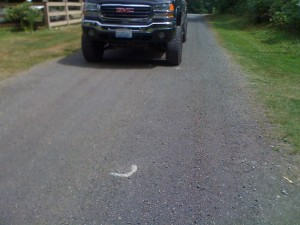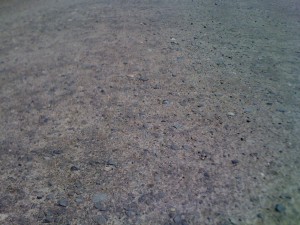Lignin Sulfonate Dust Control
An alternative to road chlorides for dust control. Lignosulfonates are derived from lignin, a naturally occurring polymer found in wood that acts like glue holding the cellulose fibers of pulp together.
Lignosulfonates work by binding the road surface particles together. Water evaporates from the lignosulfonate as it dries, and the dust particles are trapped by the high-viscosity, naturally sticky material. In addition, over time some of the lignosulfonates become completely insoluble due to solar heating.
Dark brown upon initial application, color fades as traffic and rain slowly dilute application.
Advantages
- Environmentally safe product
- Non-corrosive and non-toxic
- Lignin Sulfonate treatments tend to be more effective than Chlorides on gravel roads containing higher levels of sand
- Excellent for ungraded roads with years of accumulated tree sap residue: increased effectiveness
If Lignin Sulfonate doesn’t seem like a good fit for your situation take a look at our other dust control product Magnesium Chloride.
Free Quotes
Fill out the form or call 253-237-DUST (3878)
Frequently Asked Questions:
What are lignosulfonates and where do they come from?
Lignosulfonates are complex polymers derived from trees. (A polymer is a compound formed of many smaller molecules.) The wood from trees is composed mainly of three components – cellulose, hemicellolose and lignin. In the sulfite pulping process, the lignins are sulfonated so they become water soluble and thus can be separated from the insoluble cellulose. The soluble lignins are called lignosulfonates.
Are lignosulfonates environmentally friendly?
Extensive studies have been conducted to evaluate the effects of lignosulfonates on the environment. Results show that they are not harmful to plants, animals, or aquatic life when properly manufactured and applied. Lignosulfonates have been used as a treatment for dirt roads in Europe and the United States since the 1920’s.
How long does it last?
For most customers it lasts through the dry season requiring one application per year. Depending on weather, traffic frequency, and the type of vehicles traveling on the treated areas a second application may be beneficial.
How long do I have to wait until I can drive on it?
You can drive on it immediately after. We recommend driving slow just to keep your vehicle clean but any lignin liquid that does get on the equipment will come off by gently rubbing with a sponge or wet rag.
If possible it’s best to schedule the application after the majority of vehicles have left in the morning to avoid driving on it as much as possible. This also gives the lignin the heat of the sun and most of the day to dry.
How long does it take to dry?
On a hot dry day it will dry in a couple hours. If it’s colder and overcast it could take multiple days to fully cure but usually isn’t an issue for most customers. It just requires vehicles to go slow on the treated areas.
What preparation of the road or yard is needed?
Lignin can be applied to any gravel road regardless of shape or condition but for best results there are some things to consider. If your road already has potholes prior to application it will only prevent the potholes from getting bigger and future ones from forming. If grading the road isn’t in the budget, filling in the pot holes so there aren’t low spots for the liquid to run into can help the lignin be applied more evenly. Proper road preparation before applying a dust palliative can increase the effectiveness and longevity of lignin in a road.
Is it toxic to the environment?
No. Lignin is certified organic and is also used in cattle feed and crop fertilizers.
I live near a stream, lake, river, well water, etc., it is still ok to use this?
Yes. Lignin has been approved in some the most environmentally sensitive areas including shoreline roads boarding lakes, at ports along the sea water, and near city water sources such as lake reserves and streams.
Do I need a permit/ permission to have our road treated?
Each city, county, or government municipality can be different so you will have to check with your local jurisdiction. We have never ran into issues but if it isn’t a private road we recommend checking first as they may have their own maintenance plan and could grade it right after ruining the application. Many county’s will contract us to do roads if suggested by residents, feel free to pass our info onto your city or county road maintenance manager.
Will it hurt my pets or wildlife if they step in it or drink it?
No. It’s actually used in some animal feed as a binder for the pellet food and for cattle as a replacement for molasses.
Are there any bad smells/odors associated with Lignin?
Some people have told us it makes them hungry because it smells like barbecue and the certified safety data sheet classifies it as sweet like molasses. We would associate the smell similar to a burnt wood smell. Any smell that it does have when mixed with the fresh outdoor air is hardly noticeable and usually only present for the first few days.
How far does the application soak in or penetrate into the surface?
Usually 2-3 inches. Lignin soaks into the dirt gluing the rock in place to form a stronger road that stabilizes the top layers as well as the road base. This prevents potholes and creates long lasting road stabilization, not just a crust on top of the road that would quickly wear out and be torn up. Instead the lignin binds the road material together to create a firm road and smooth driving surface.
Do lignosulfonates contain heavy metals?
Lignosulfonates are derived from wood and thus contain trace amounts of the metals that are naturally present in trees. The levels and types of metals vary depending upon the types of trees and the soil on which they were grown. The amounts of metals typically found in lignosulfonates are well below the current EPA limit of one part per million. The industry has voluntary standards for the levels of heavy metals in lignosulfonates.
Is there a Material Safety Data Sheet available?
Yes, we can easily email you a copy at your request, simply contact us by email (sales@pacificdustcontrol.com), calling, or by filling out a contact form.




 Studies have shown that roads maintained with stabilization/dust control products save money by not having to grade and re-gravel as frequently. In addition, you get the added benefit of no dust!
Studies have shown that roads maintained with stabilization/dust control products save money by not having to grade and re-gravel as frequently. In addition, you get the added benefit of no dust!
 An affordable solution to all your dust control needs.
An affordable solution to all your dust control needs.
